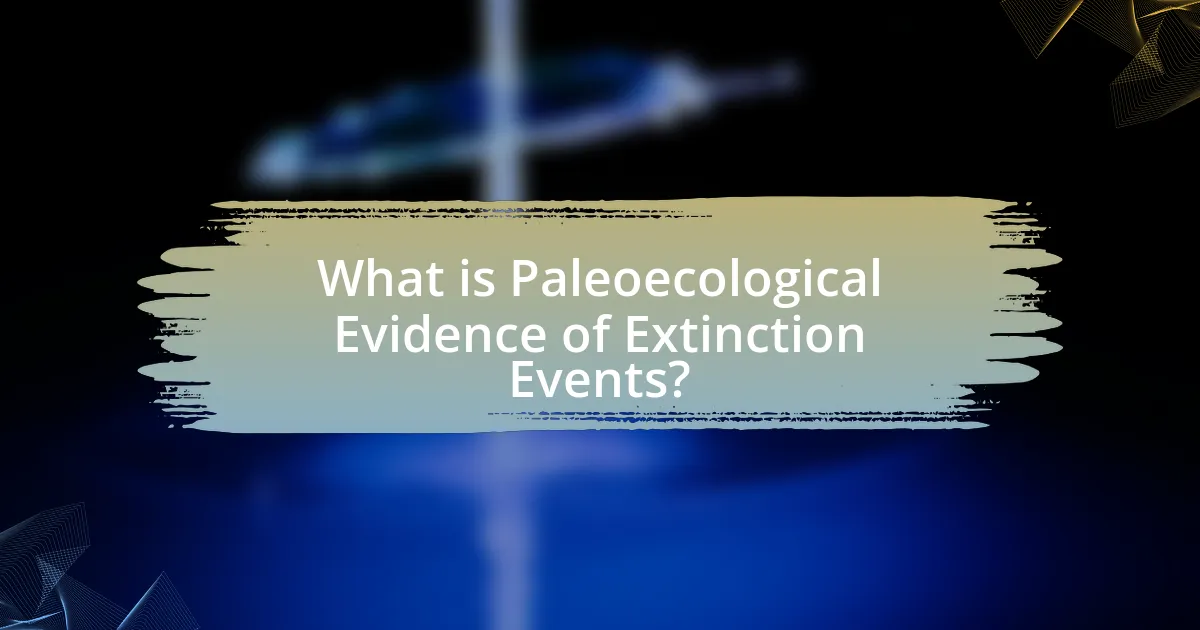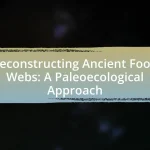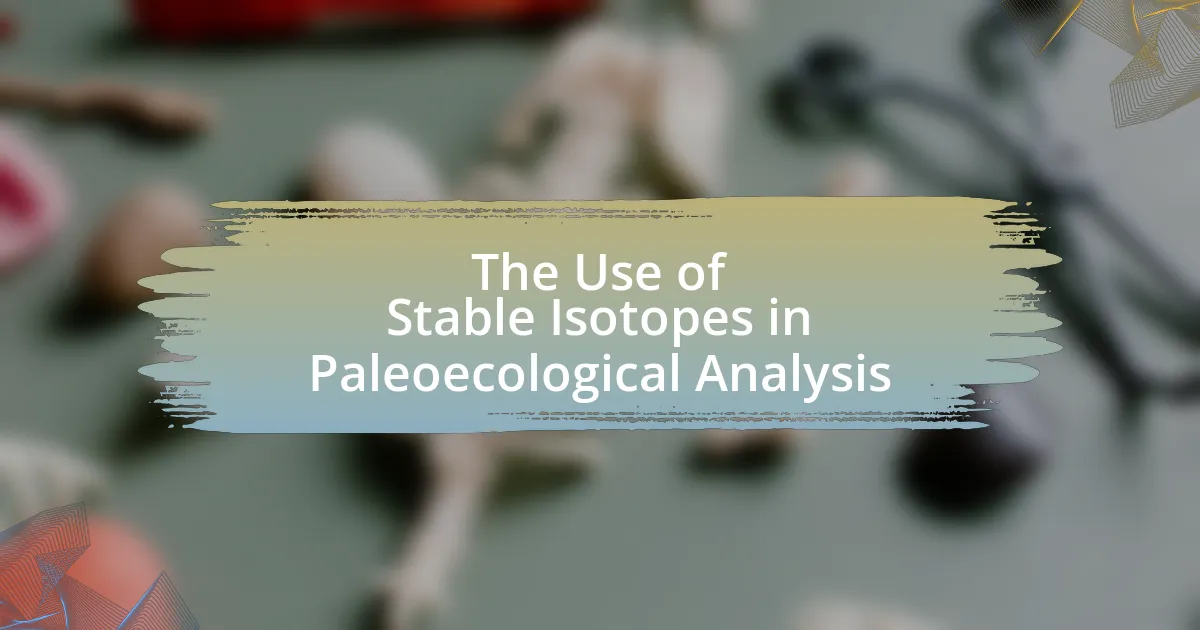Paleoecological evidence of extinction events encompasses data from ancient ecosystems that indicate periods of species disappearance from the fossil record. This article explores the methodologies used in paleoecological research, including fossil records, sediment analysis, and isotopic studies, to understand the dynamics of extinction events and their impact on biodiversity. Key extinction events, such as the end-Cretaceous and Permian-Triassic extinctions, are examined to highlight the role of environmental stressors in species loss. The findings underscore the significance of these events in informing current conservation efforts and understanding the implications of ongoing biodiversity crises.

What is Paleoecological Evidence of Extinction Events?
Paleoecological evidence of extinction events refers to the data derived from the study of ancient ecosystems that indicate periods when species disappeared from the fossil record. This evidence includes fossilized remains, sediment analysis, and isotopic data that reveal shifts in biodiversity and environmental conditions. For instance, the end-Cretaceous extinction, marked by the disappearance of dinosaurs, is supported by a layer of iridium-rich clay found globally, indicating a massive asteroid impact. Such findings provide concrete proof of the dramatic changes in species composition and ecosystem dynamics during these extinction events.
How do paleoecological studies contribute to understanding extinction events?
Paleoecological studies contribute to understanding extinction events by analyzing ancient ecosystems and the environmental conditions that preceded and followed these events. These studies utilize fossil records, sediment analysis, and isotopic data to reconstruct past climates and biodiversity patterns, revealing how changes in habitat, climate, and species interactions may have led to extinctions. For instance, research on the end-Permian extinction indicates that significant volcanic activity and resultant climate change drastically altered ecosystems, leading to the loss of approximately 90% of marine species. Such evidence underscores the role of environmental stressors in extinction events, providing critical insights into the mechanisms behind these occurrences.
What types of data are collected in paleoecological research?
Paleoecological research collects various types of data, including fossil records, sediment samples, and isotopic analyses. Fossil records provide insights into past species diversity and community structures, while sediment samples reveal information about ancient environmental conditions and climate changes. Isotopic analyses, such as carbon and oxygen isotopes, help reconstruct past temperatures and ecological dynamics. These data types are essential for understanding extinction events and the ecological responses to environmental changes throughout Earth’s history.
How is this data analyzed to infer extinction patterns?
Data is analyzed to infer extinction patterns through the examination of fossil records, sediment cores, and isotopic analysis. Researchers utilize these methods to identify changes in biodiversity, species distribution, and environmental conditions over time. For instance, fossil records provide direct evidence of species presence and absence, while sediment cores reveal shifts in habitat and climate that correlate with extinction events. Isotopic analysis can indicate changes in food webs and ecological dynamics. Studies, such as those published in “Nature” by Jablonski (2001), demonstrate that correlating these data types allows scientists to reconstruct past ecosystems and identify the factors contributing to extinction events.
Why are extinction events significant in paleoecology?
Extinction events are significant in paleoecology because they provide critical insights into the dynamics of ecosystems and the processes of evolution. These events, such as the Permian-Triassic extinction, which eliminated approximately 90% of marine species, reveal how biodiversity responds to catastrophic changes, including climate shifts and habitat loss. By studying the fossil record and sedimentary layers associated with these events, researchers can understand patterns of species recovery, adaptation, and the long-term impacts on ecological communities. This knowledge is essential for predicting future biodiversity responses to ongoing environmental changes.
What are the major extinction events identified in Earth’s history?
The major extinction events identified in Earth’s history include the Ordovician-Silurian extinction, the Late Devonian extinction, the Permian-Triassic extinction, the Triassic-Jurassic extinction, the Cretaceous-Paleogene extinction, and the Holocene extinction. The Ordovician-Silurian extinction, occurring around 443 million years ago, eliminated approximately 85% of species, primarily due to climate change and sea level fluctuations. The Late Devonian extinction, around 375 million years ago, saw a loss of about 75% of species, likely linked to changes in sea levels and anoxic events. The Permian-Triassic extinction, about 252 million years ago, is the most severe, with around 96% of marine species and 70% of terrestrial vertebrates going extinct, attributed to volcanic activity and climate change. The Triassic-Jurassic extinction, approximately 201 million years ago, resulted in the extinction of about 80% of species, possibly due to volcanic eruptions and climate shifts. The Cretaceous-Paleogene extinction, around 66 million years ago, famously led to the demise of the dinosaurs, with around 75% of species lost, primarily due to an asteroid impact and volcanic activity. Lastly, the Holocene extinction, ongoing since the last Ice Age, is characterized by significant species loss due to human activities.
How do these events impact biodiversity and ecosystems?
Extinction events significantly reduce biodiversity and disrupt ecosystems. These events lead to the loss of species, which diminishes genetic diversity and alters community structures. For example, the Permian-Triassic extinction, the most severe in Earth’s history, eliminated approximately 90% of marine species and 70% of terrestrial vertebrates, resulting in long-term ecological shifts. Such drastic reductions in biodiversity can destabilize ecosystems, as the interdependent relationships among species are disrupted, leading to cascading effects on food webs and ecosystem services.
What methodologies are used in paleoecological research on extinction events?
Paleoecological research on extinction events employs methodologies such as sediment analysis, fossil examination, and isotopic studies. Sediment analysis involves examining layers of earth to identify changes in environmental conditions over time, which can correlate with extinction events. Fossil examination focuses on studying the morphology and distribution of extinct species to understand their ecological roles and responses to environmental changes. Isotopic studies analyze the ratios of stable isotopes in fossilized remains to infer past climate conditions and biological processes. These methodologies collectively provide insights into the timing, causes, and consequences of extinction events, supported by evidence from various geological and biological records.
How do sediment cores provide insights into past environments?
Sediment cores provide insights into past environments by capturing layers of sediment that accumulate over time, which contain preserved biological, chemical, and physical records of historical conditions. These layers can reveal information about climate changes, ecological shifts, and extinction events through the analysis of fossilized remains, isotopic compositions, and sediment characteristics. For example, studies of sediment cores from ocean floors have shown variations in foraminiferal assemblages that correlate with known extinction events, indicating shifts in marine biodiversity and environmental conditions during those periods.
What role do fossil records play in understanding extinction events?
Fossil records are crucial for understanding extinction events as they provide direct evidence of past life forms and their environments. By analyzing fossilized remains, scientists can identify patterns of biodiversity loss, track changes in species composition, and correlate these changes with environmental shifts or catastrophic events. For instance, the fossil record reveals that the Permian-Triassic extinction, which occurred around 252 million years ago, resulted in the loss of approximately 90% of marine species, highlighting the severity of the event. Additionally, fossil records allow researchers to reconstruct ecosystems and assess the impact of factors such as climate change, volcanic activity, and asteroid impacts on species survival. This data is essential for understanding the mechanisms behind extinction and the resilience of life on Earth.
How does paleoecological evidence link to current biodiversity crises?
Paleoecological evidence links to current biodiversity crises by revealing patterns of past extinction events and their causes, which can inform our understanding of contemporary biodiversity loss. For instance, studies of fossil records indicate that rapid climate changes and habitat destruction historically led to significant species declines, similar to the current threats posed by anthropogenic climate change and habitat fragmentation. Research published in “Nature” by Barnosky et al. (2011) highlights that the current rate of species extinction is estimated to be 100 to 1,000 times higher than the natural background rate, a phenomenon that mirrors past mass extinction events documented in the geological record. This correlation underscores the importance of paleoecological insights in predicting and mitigating the impacts of ongoing biodiversity crises.
What lessons can be learned from past extinction events?
Past extinction events reveal critical lessons about biodiversity, ecosystem resilience, and the impact of environmental changes. These events, such as the Permian-Triassic extinction, which eliminated approximately 90% of marine species, highlight the vulnerability of ecosystems to rapid climate shifts and habitat loss. Additionally, the Cretaceous-Paleogene extinction, linked to an asteroid impact, underscores the potential for sudden catastrophic events to disrupt life on Earth. Understanding these patterns emphasizes the importance of conserving biodiversity and maintaining ecosystem health to mitigate the risks of future extinctions.
What are the implications of paleoecological findings for conservation efforts?
Paleoecological findings significantly inform conservation efforts by providing insights into historical ecosystems and species interactions. These findings reveal patterns of biodiversity loss and resilience, enabling conservationists to identify critical habitats and species that require protection. For instance, studies of past extinction events, such as the Late Pleistocene megafauna extinction, highlight the impact of climate change and human activity on species survival. Understanding these historical contexts allows for the development of more effective conservation strategies that consider both current environmental changes and historical ecological dynamics.
How can understanding past extinctions inform current species protection strategies?
Understanding past extinctions can inform current species protection strategies by revealing patterns of vulnerability and resilience among species. Historical data indicates that environmental changes, such as climate shifts and habitat loss, have consistently led to species declines, as seen during the Permian-Triassic extinction event, which eliminated approximately 90% of marine species. By analyzing these patterns, conservationists can identify at-risk species and prioritize their protection based on similar ecological pressures. Additionally, insights from past extinctions highlight the importance of genetic diversity and adaptive capacity, guiding current strategies to enhance these traits in endangered populations. This evidence-based approach ensures that protection efforts are grounded in historical context, increasing their effectiveness in preventing future extinctions.
What best practices can be derived from paleoecological research?
Best practices derived from paleoecological research include the integration of multi-proxy data to reconstruct past environments, the use of statistical models to analyze ecological changes over time, and the application of spatial analysis to understand species distribution and extinction patterns. Multi-proxy data, such as pollen, isotopes, and fossil records, provide a comprehensive view of past ecosystems, allowing researchers to validate findings and enhance accuracy. Statistical models, like generalized additive models, help in identifying trends and predicting future ecological responses based on historical data. Spatial analysis techniques, including Geographic Information Systems (GIS), enable the mapping of extinction events and habitat changes, facilitating a better understanding of the factors influencing biodiversity loss. These practices are supported by numerous studies, such as those published in the journal “Paleoecology,” which emphasize the importance of a multidisciplinary approach in understanding extinction events and their ecological implications.





